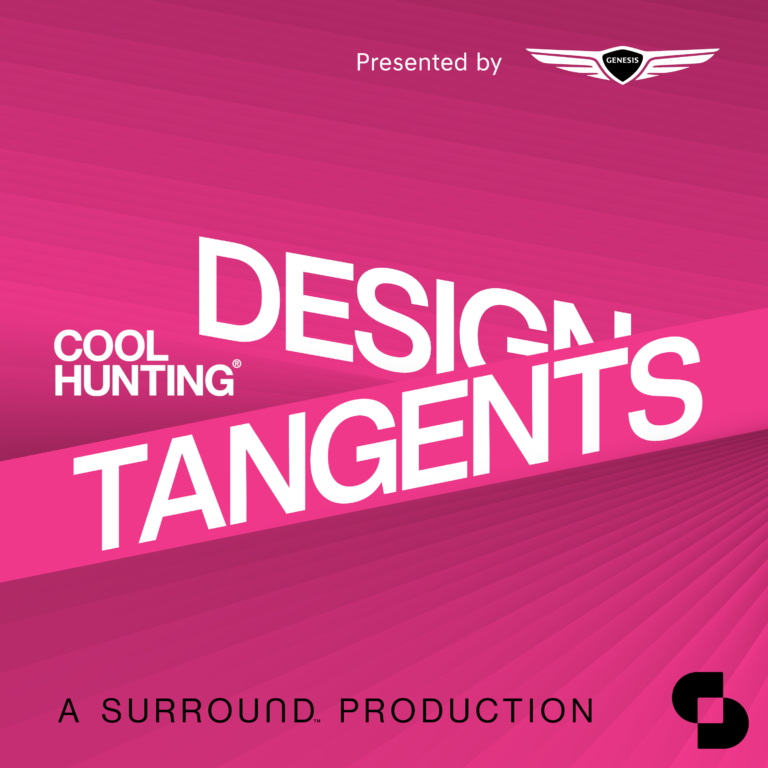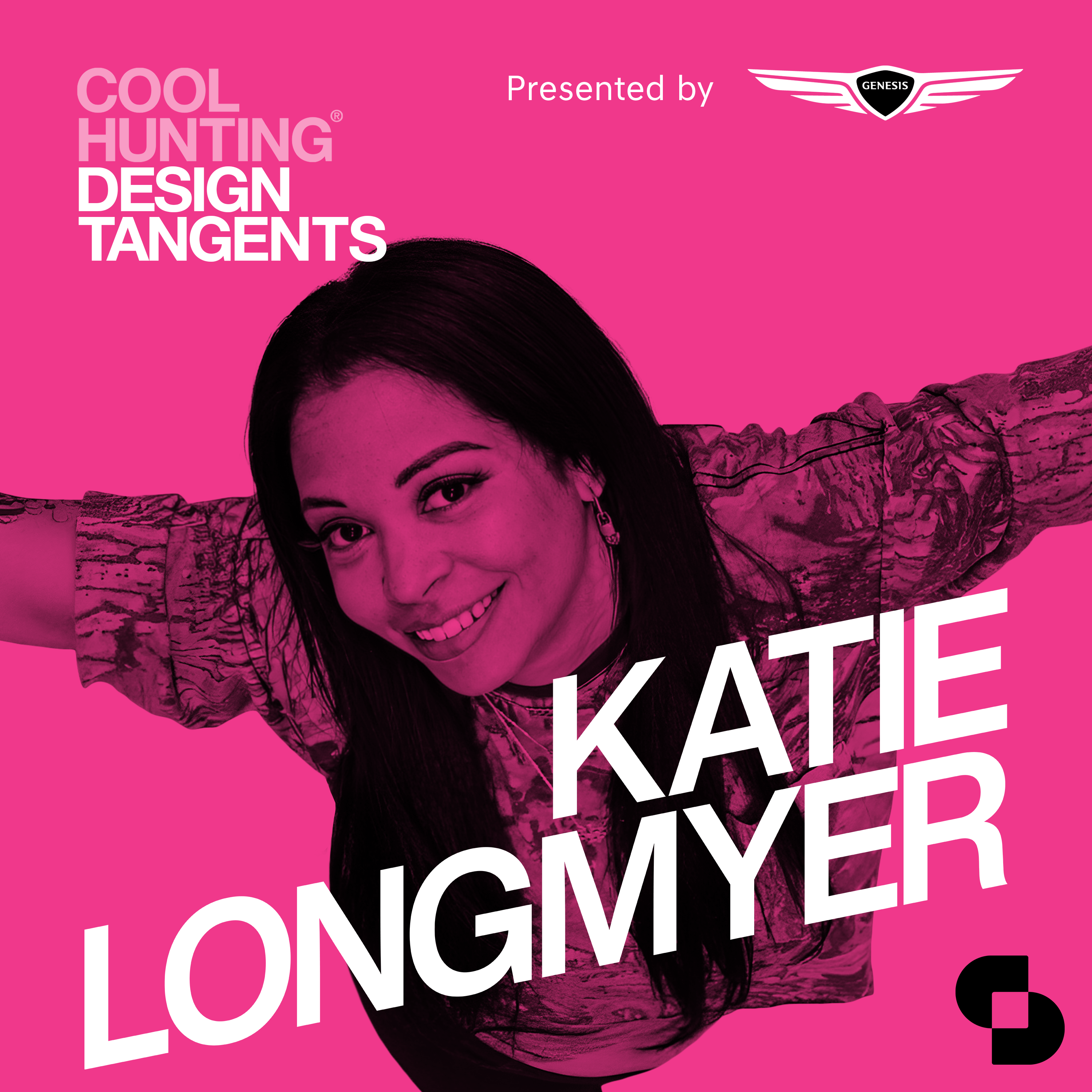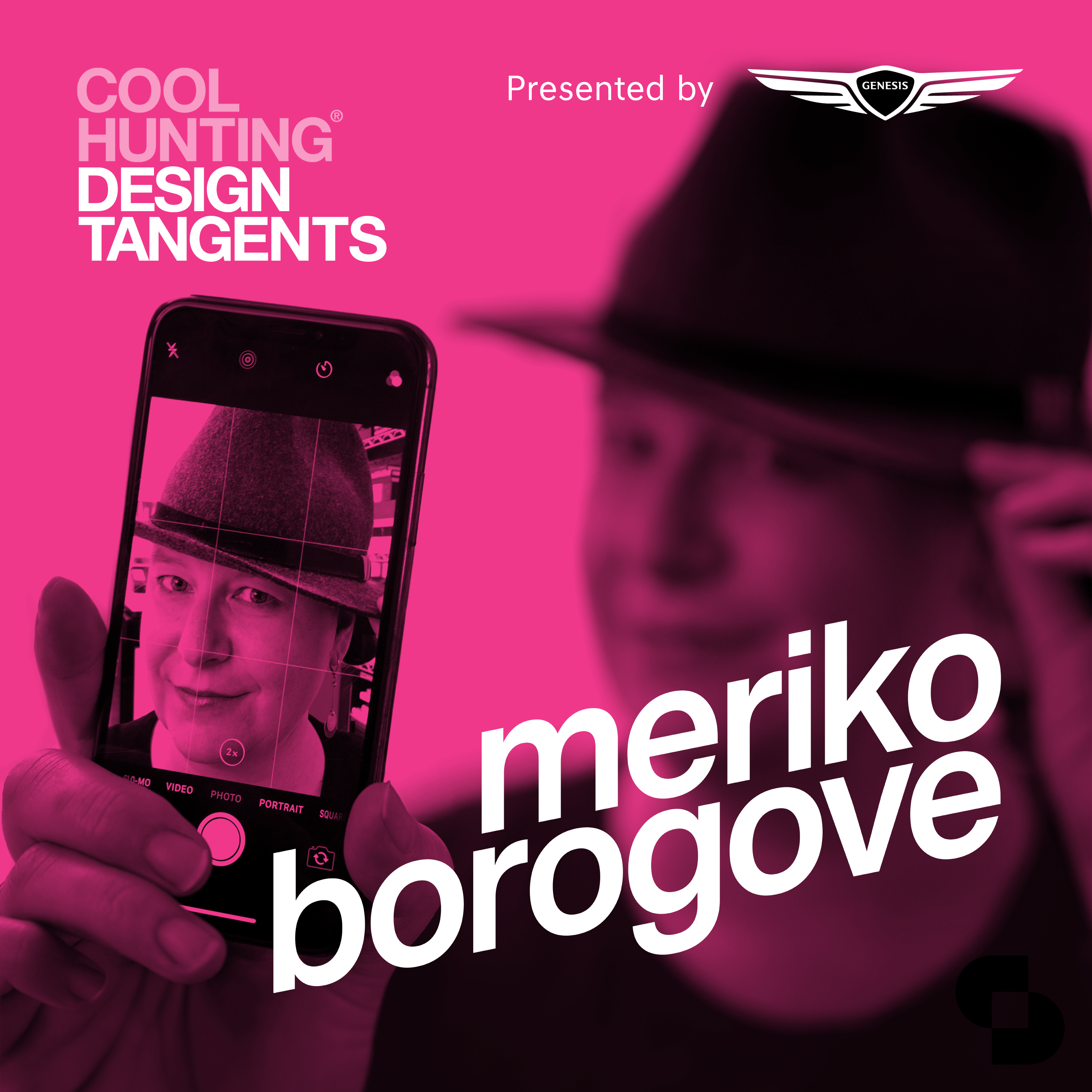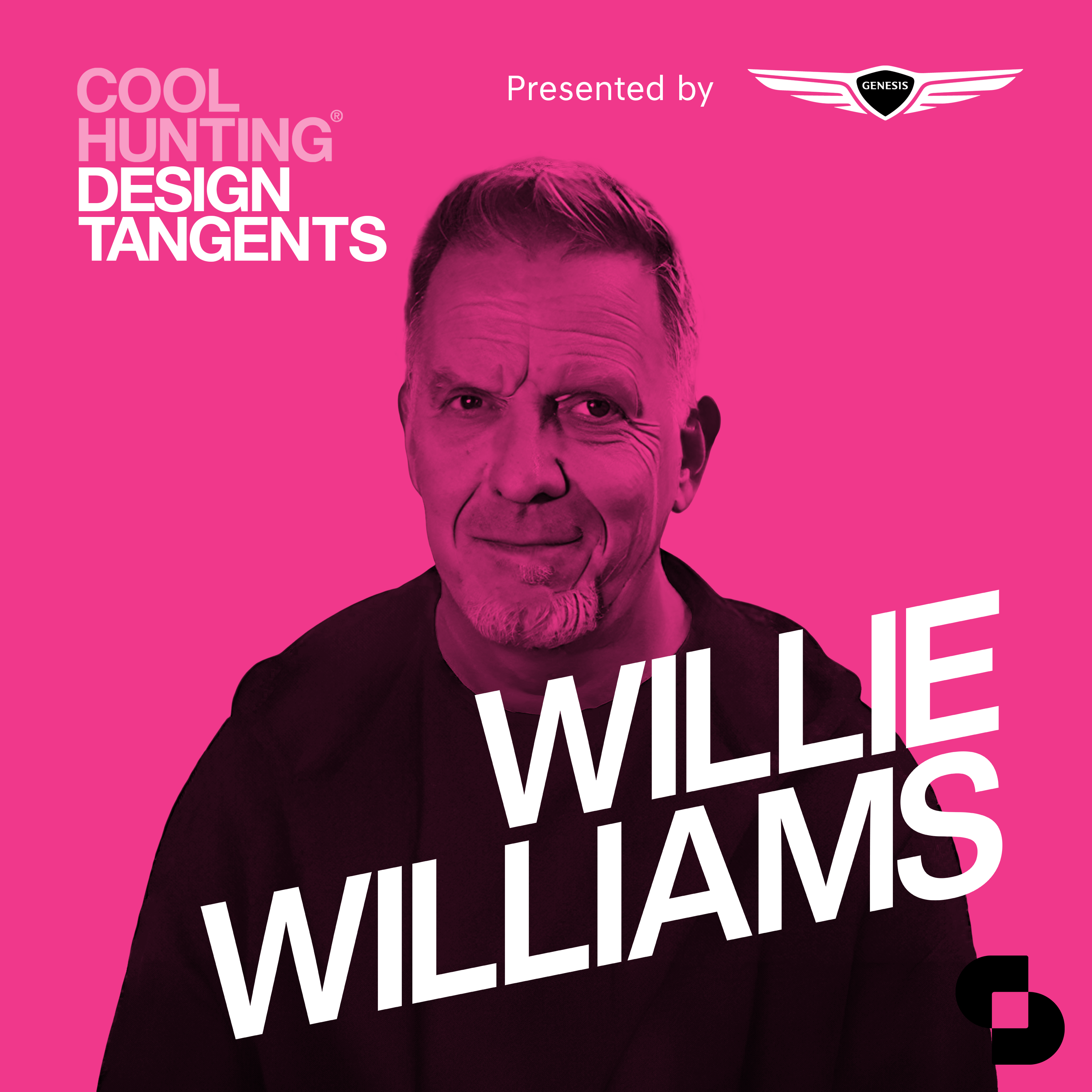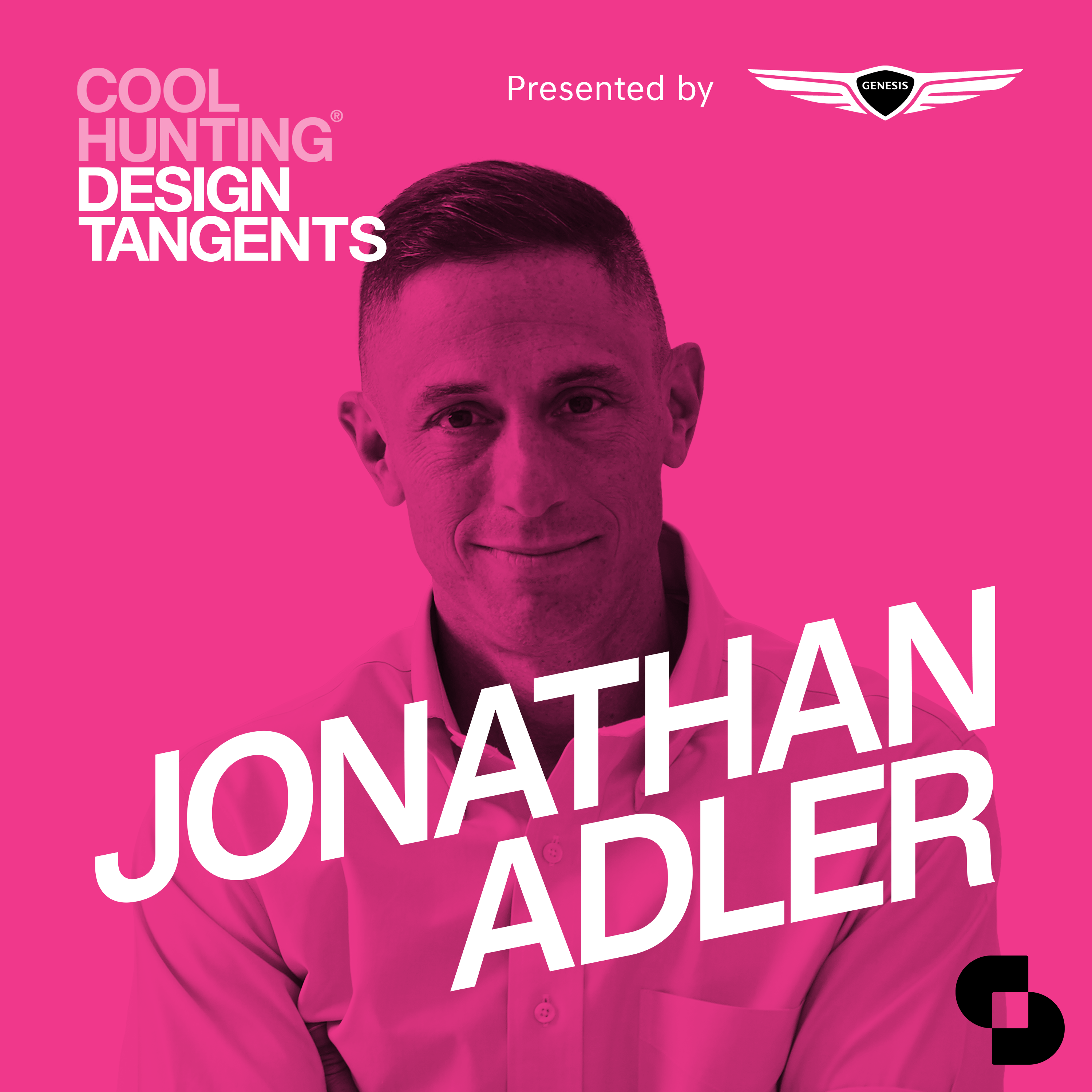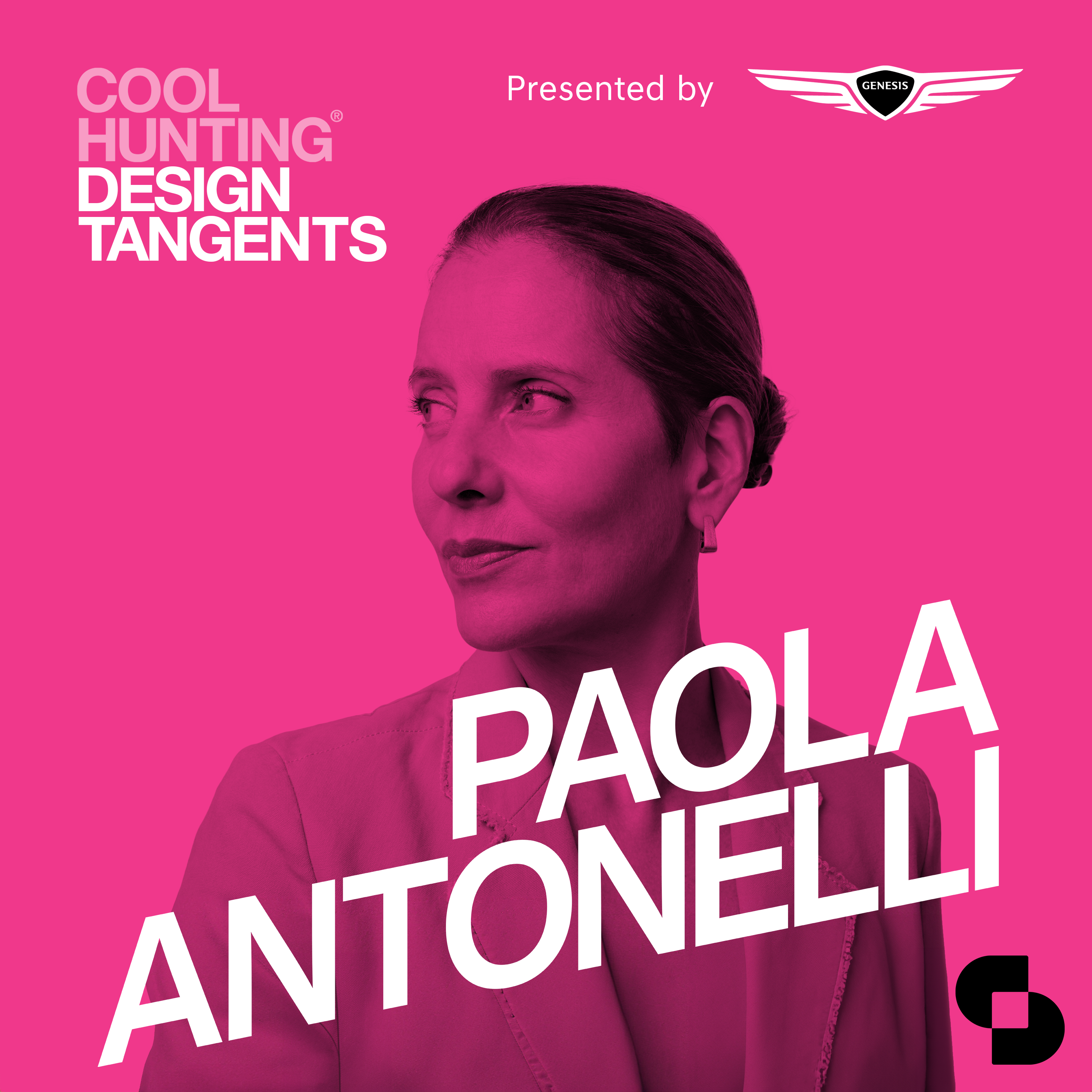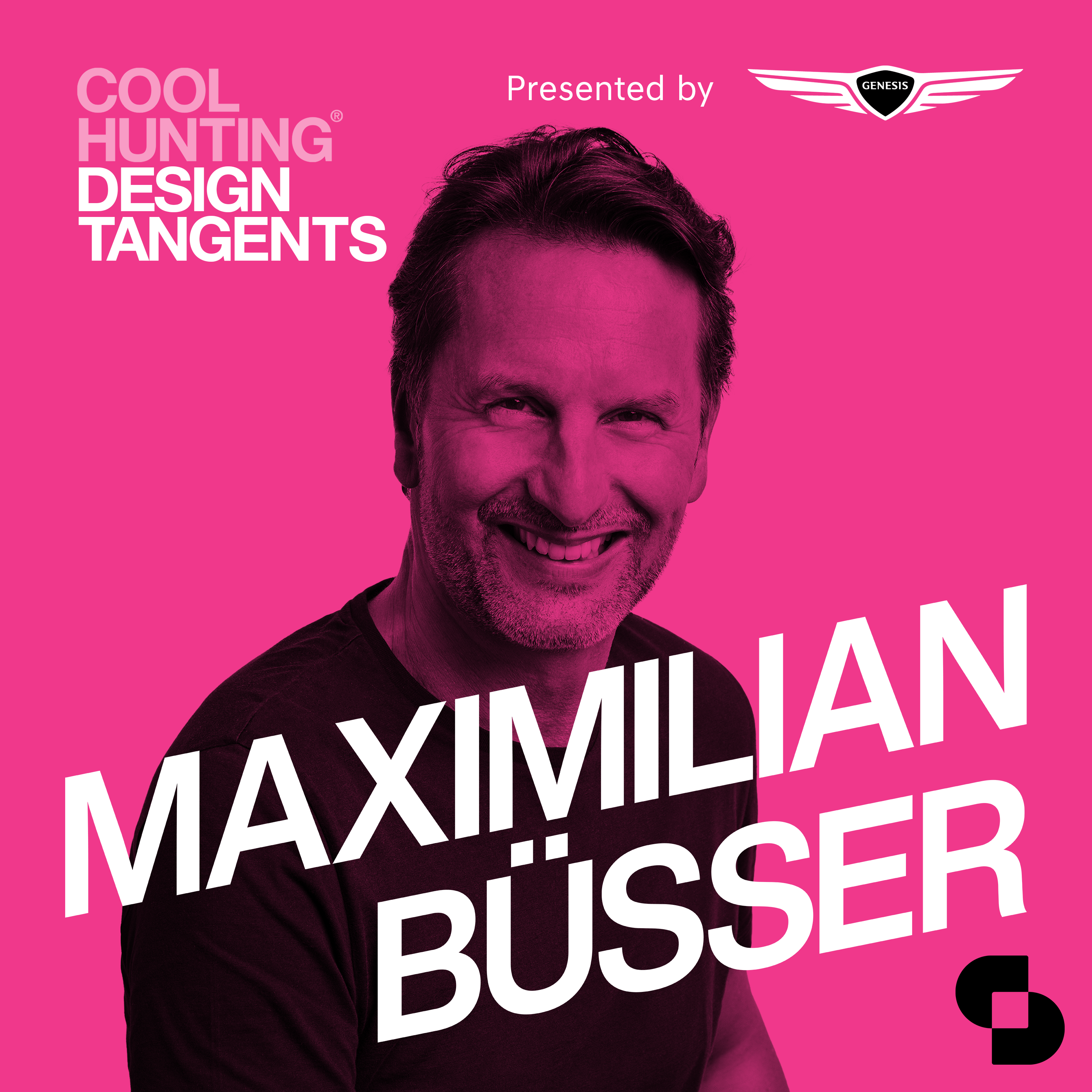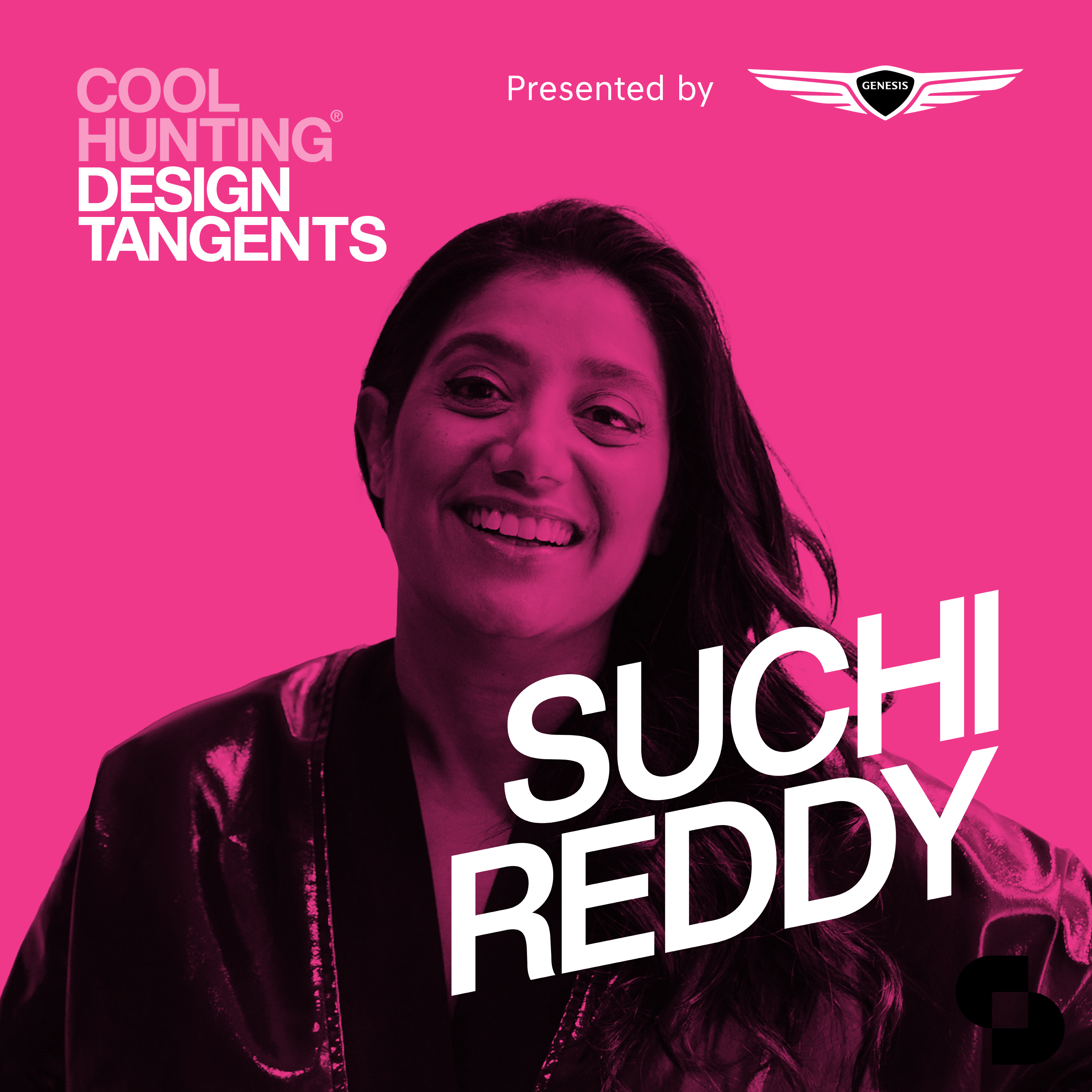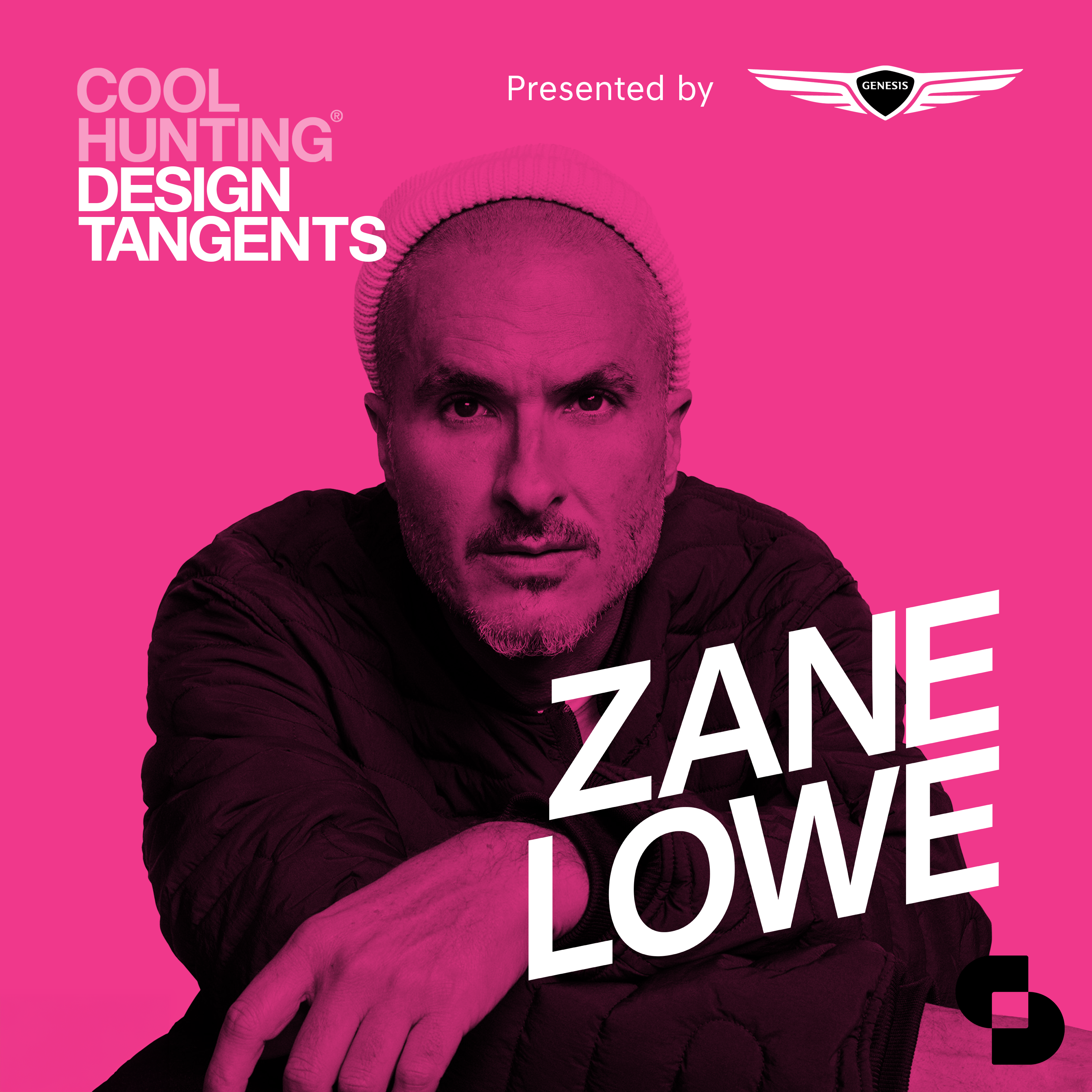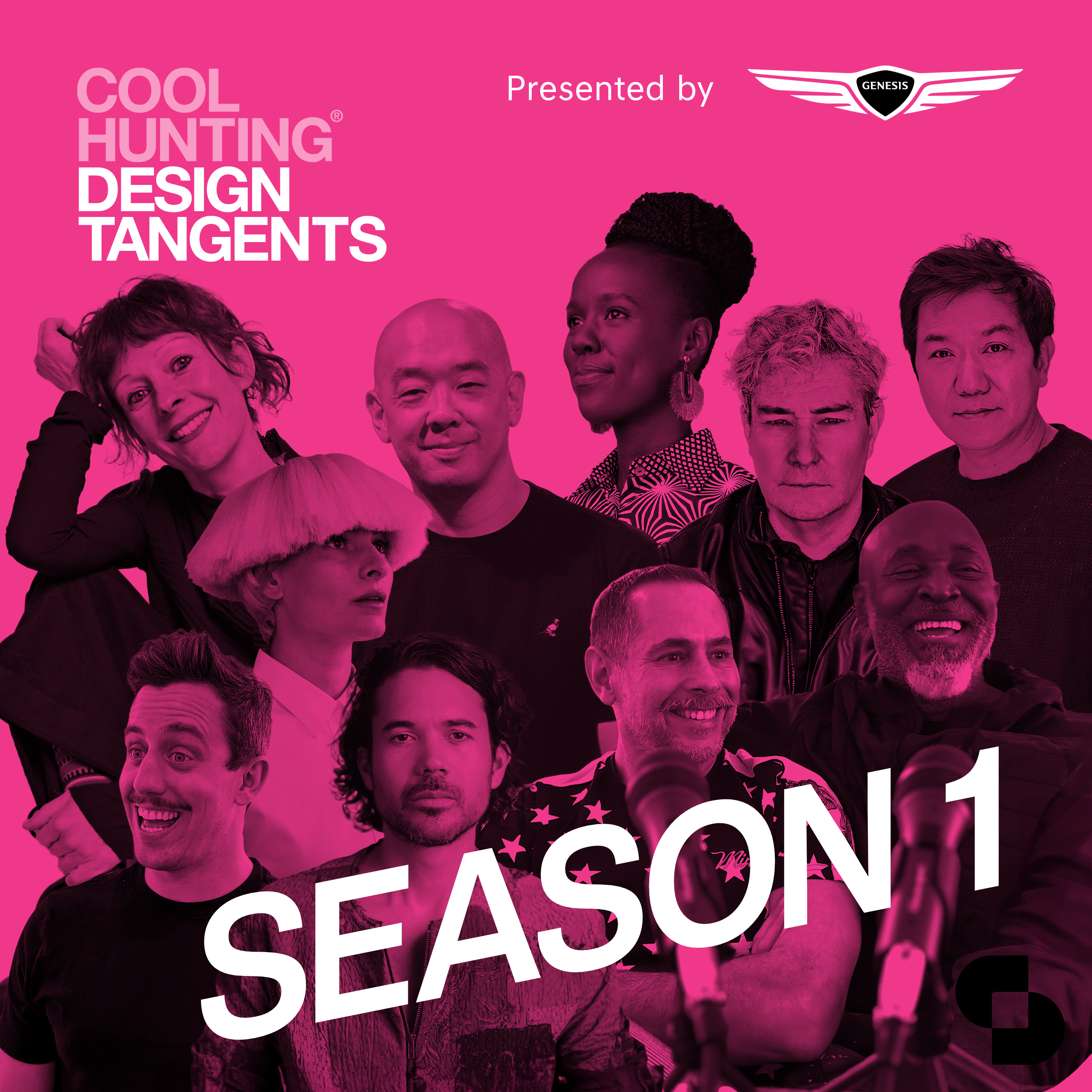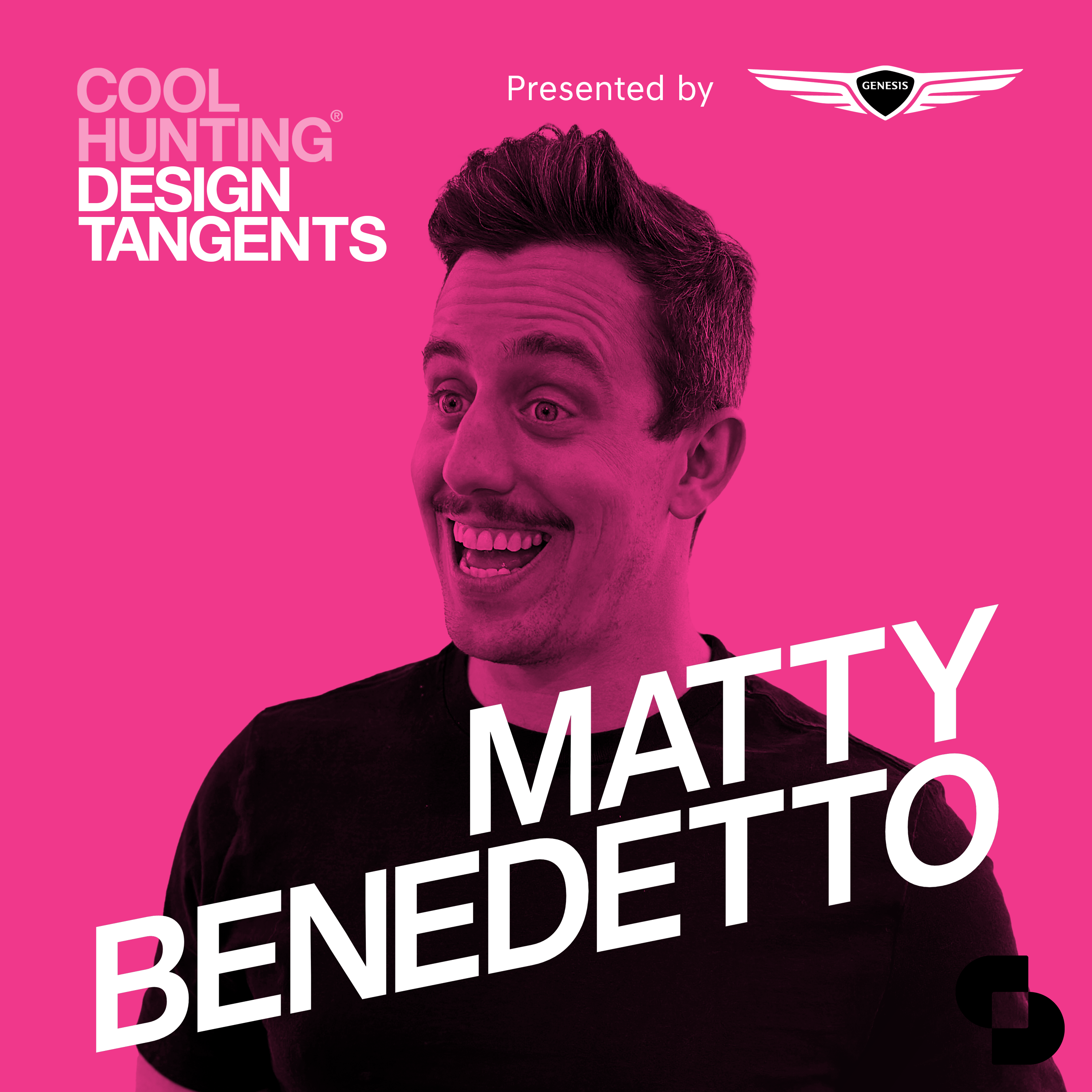A multi-hyphenate creative, Matthew Dear is a tech-forward composer and performer, a DJ, digital artist and web3 enthusiast. COOL HUNTING first wrote about him in 2007, and he appeared in our video podcast then, early in his musical career. Over the years Josh and Evan followed his work and developed a friendship. Thinking about creating theme music for Design Tangents Matthew was the first and only person on the list, and it was a no brainer to also have him on as a guest. We went back to Ann Arbor, where we shot our video 15 years ago, to talk about what he’s interested in making today, what went into writing our theme music, and how having children, fishing, technology and the Detroit scene all play a role in his creative process.
Links
coolhunting.com/culture/matthew-dear-nu
coolhunting.com/?s=Matthew dear
ghostly.com/artists/matthew-dear
Discover more shows from SURROUND at surroundpodcasts.com.
This episode of Design Tangents was produced and edited by SANDOW Design Group.
Special thanks to the podcast production team: Rob Schulte, Hannah Viti, Wize Grazette, and Samantha Sager.
Transcripts, show notes, and links for each episode of Design Tangents can be found at surroundpodcasts.com/design-tangents
[00:00:00] Matthew Dear: My name’s Matthew Dear. There’s so many different ways you can get into what I do. And every time I meet somebody or hear somebody, I wonder what avenue they took to find me. Cause I DJ all around the world. But I’ve been at places I’ve played in Berlin. A girl came up to me after my DJ said that that was the worst DJ set I’ve ever heard in my life.
You didn’t play any of the songs that you made. And I was thinking, oh, don’t play that. Matthew Deer when I’m in a nightclub.
[00:00:24] Evan Orensten: Welcome to Design Tangents, a podcast that goes behind the scenes with creative change makers to learn about their work, inspiration, challenges, and philosophies.
[00:00:34] Josh Rubin: I’m Josh Rubin.
[00:00:35] Evan Orensten: I’m Evan Orensten.
[00:00:36] Josh Rubin: We’re the founders of Cool Hunting.
[00:00:37] Evan Orensten: We launched our first podcast in 2005. Now that was a video podcast and it ran for 15 years or so.
[00:00:45] Josh Rubin: One of our first episodes was with Matthew Deer. Visiting him in Michigan and learning about how he thinks about him makes music, so it just felt appropriate for this debut season of design.
Tangents to revisit Matthew.
[00:00:59] Evan Orensten: [00:01:00] He’s a composer, a musician, a dj, a fine artist. We went back to our roots and sat down with Matthew at his house in Michigan.
[00:01:08] Josh Rubin: We’re excited for you to hear this episode.
[00:01:10] Evan Orensten: We’re also really excited that Matthew created the music for our podcast.
[00:01:19] Josh Rubin: I am so excited for this conversation cuz to me it’s like a poetic little bridge from our very first podcast.
[00:01:26] Evan Orensten: I don’t remember exactly when we met, but we met I think before we did our video with you back in 2007. . And I remember that episode and it was really great. We actually filmed that or part of it.
You were fishing and . And it’s quite near where we are
today.
[00:01:41] Matthew Dear: Yes, a hundred percent. There was a Dam Barton Dam. And I had actually, I was going there on my own. I was delivering pizza. I think shortly before that. That’s after I quit my, my last day job. But during that, that time, delivering pizzas and driving around Ann Arbor, I got to know a lot of [00:02:00] the kind of nooks and crannies of the town.
And there was a little off-road that went to Barton Dam and I’d go back there and fish every now and then. I grew up in Texas fishing with my father. He was kinda a, a commercial fisherman where you’d catch fish and sell them to. To restaurants and all that. So like, I grew up doing that in, in Texas, so fishing was always very much a part of my life as a way to, you know, kill the time.
Like my dad would be driving down the street or I’m down the highway to do something in Texas and we’d always have fishing equipment in the back of the truck or suburban whatever. And uh, oh, we, this looks a great spot. We’ll just pull off here and throw some certain lures in the Guadalupe River for a little bit.
So I always have that mentality. And I think when you guys were. Coming by and like looking for stuff to film. It’s like, Hey, let’s go fishing. You know, I’ve got, got some stuff still. And we stopped by. Really cool. Uh, what they call what, um, mini Marts here which are basically a party stores, or no, we call it party stores, but you guys call it, uh, [00:03:00] bodega More in New York.
And we stopped by there and got some. Some worms there and we went fishing for a bit and I, I didn’t catch anything. I remember that made a tiny little fish.
[00:03:10] Evan Orensten: This is very fresh for us cuz we just watched that a couple times this week and when we made that video you were well known to some people. Yeah.
You’d already kind of co-founded a record label.
[00:03:21] Matthew Dear: Yeah. Sam, from the beginning. Uh,
[00:03:23] Evan Orensten: at Ghostly
[00:03:24] Matthew Dear: at Ghostly International, also from Ann Arbor here.
[00:03:27] Evan Orensten: You were you met in college?
[00:03:28] Matthew Dear: We did, yeah. Sam Sam’s an incredible individual, Sam Valenti at the fourth. Uh, for those listening, he saw me performing live at a house party.
I knew some of the guys there. Uh, and I, I had coerced them into letting me set up all my electronic equipment in the basement of this top 40 party that they would have upstairs. And, um, here I was with I think a keyboard and a sampler in my own pa and of the five or 10 people that came [00:04:00] through the basement that night, Sam was one of them.
He saw what I was doing and like, wow, like didn’t expect to see a guy making live techno here. Uh, and he introduced himself and said, Hey, I really dig what you do. I wanna start a label. And we went in that coffee the next week. He gave me his dorm room number and for lack of a better, uh, you know, phrase, the rest was history.
You know, the, the label is Sam Valenti. And, uh, I was the founding artist and I really lucked out, you know, had I not met him, you know, I, I took a meeting with Carl Craig, Planet E like I, about six months before that, uh, just on a whim, somebody I knew. Knew him and got me a meeting in Detroit. And I love to tell Carl the story.
I dunno if he ever remembers it, like, you wanna talk to him? Mm-hmm. Like, uh, guess Carl’s just awesome like that. But he gave me all the, he, he ended up hearing some of my tapes and gave me a stack of all the Planet E cds. There’s like Moody Man, Recluse um, a few other people. And you said like, Basically go do your homework.
Yeah. Like you’re not quite [00:05:00] ready. Like take these, listen to it, and then come back. And it was, so that was six months before I met Sam. So I was, I was out there, I was trying to get myself out there. I realized that I had this urge to release music, but meeting Sam was such a crucial part of me becoming a a, an actual artist.
I think in that sentence where, I could show Sam a guitar song that I made one day, um, with a tape player and, and some loops and stuff. And then I could show him a techno song and he would get it and he would be like, oh yeah, we have a place for that. Or We at least have a place for your creative mind that way.
And I think the, the track record has proven that to be so, you know, I, if I’ve released very acoustic sounding songs, I’ve re I’ve released techno that could be played in a nightclub. And it’s all because of Sam’s, um, belief and confidence in my ability to just be free and do what I wanna do. So hats off to Sam and Ghostly International [00:06:00] as being my, that’s like my house, you know, that’s my, my label.
I, I couldn’t see myself ever. Of course, I release on other labels in certain formats, but I would never not release on Ghostly.
[00:06:10] Evan Orensten: It’s, it’s part of who you are
[00:06:12] Matthew Dear: a hundred percent. And it’s not like Sam isn’t up for exploring and trying different, uh, outlets. And that’s also what makes it so good.
[00:06:21] Josh Rubin: We love so many of the, some of the artists that are on, on Ghostly but we also really love the merch.
Um, I’m actually wearing Ghostly t-shirt. This is an unofficial collaboration between myself and Ghostly. Because I bought it from you all and then ice-dyed it.
[00:06:36] Matthew Dear: I like it.
[00:06:37] Evan Orensten: It’s funny you mentioned all this, Matthew, because one of the things that I wrote down Yes. In preparing for this was something that Sam said about you in 2007 that’s actually in this. Our podcast video. He said the thing about Matthew as an artist, Is that he’s unafraid to explore anything that’s in his brain, and it kind of just reflects what you just said. Like he was always there for you, not trying to pigeonhole you, [00:07:00] saying, Hey, you’re good at whatever techno or dance music or whatever.
He was like, Hey, as an artist, whatever you feel like expressing. I wanna be supportive of
that.
[00:07:10] Matthew Dear: And I love all the different labels I can release on Pearl Lawn and Berlin, and, but they don’t, I would never send them the, the weirder stuff they send Sam. Yeah. So, and it’s so lucky, you know, I’m so lucky to have that.
It could be a lot different. If I, if I did not meet Sam, I think I would struggle a lot with choices of limiting myself, you know, and not putting out or showing people certain things.
[00:07:36] Josh Rubin: You talked about some of your early musical influences and, and how Carl Craig kind of introduced you to more, and, and that’s of course an ongoing journey.
I’d love to hear a little bit about. Your visual influences. Because you’re highly visual person as well as a music maker.
[00:07:58] Matthew Dear: Totally. And more [00:08:00] so recently, I think, um, um, I don’t know if it’s just having, you know, I’ve had three children now. There’s, there’s a thing with music, you know, where you’re, when I’m younger, I’m thinking, okay, you’ll never not do this.
Um, you’re, you’re a Bowie, you know, you’re like a Lou Reed, like, You’re a Prince. In your mind, you’re thinking this is what you do for the rest of your life. Um, there’s no doubt about that, but something’s happened where I think just the, the, the onslaught of musicians and the ability to make music so.
Prevalent. And I love that. And I, I love, I think we hear so much music that we would not have heard of at the iPhone, not have had such amazing apps or software had become so prevalent. Now there’s software that people use on, on web websites now. You can like make music, uh, and mix music and that’s great.
And I think so many people have access to it now. So something has happened. I think in that, that change that maybe made me do a a [00:09:00] few. Second guesses or just maybe lost my, my total undying, uh, unfettered like passion to just make music all the time. I still do, like, I love sitting down in the studio and tinkering with sound and, and playing with synthesizers, playing with my voice and effects and everything.
But releasing music, I think has kind of become a bit harder for me. And intro, introduce art now, um, all of a sudden. Definitely during the pandemic, I made a choice. I said, look, I’m gonna take this opportunity to finally really learn programs like, uh, Adobe After Effects and, uh, Premiere. I’m gonna learn how to edit and I’m gonna learn how to dabble and Illustrater or graphic design and things that I had been so either afraid to touch or just didn’t have the time.
To touch and try to get it, get it right, but I looked at it like music. You know, when I started making music, you don’t [00:10:00] know what you’re doing. You have an idea of what you want to do, what you’re gonna sound like. But when you’re young, it just doesn’t matter. You don’t really, you don’t give a shit and you shouldn’t if you’re, if you’re trying to be a musician.
But I didn’t have that bravado or that confidence with visual arts because I hadn’t chose that route or, or film or editing. You know, I didn’t, I didn’t choose that as an, as an 18 year old or 16 year old. So I always thought of it as off limit, you know? So slowly but surely, I think I started with like dad memes and jokes.
Which is making like the most weird, like cut up Photoshop, like, like app stuff on my phone. But I’ll also start. You know, getting into like, os based stuff, like on the, on the computer and it just slowly morphed into something. I was like, oh, maybe I can actually show this to Michael Cheena, who does my art for, for ghostly, and maybe I could show this to Sam and, you know, bless their hearts.
And he’d say In the south they really, uh, you know, gave me my space to grow. I’m sure they saw some things I was showing them, [00:11:00] like, oh, that’s cute, man. Keep trying. But no, they’ve been a, they’ve been fun to like bounce ideas off of. And again, you know, It’s a totally different beast. Uh, visual arts. It’s, it’s cool in the sense that I, I’m never the type of artist to, um, to say my stuff is, is good music or not, you know?
But definitely visual arts, you know, but it’s, it’s, it has sold a few things there, whether it be N F T or actually sold some physical products, doesn’t, some fans. Early on that I was doing some actual painting and, and I’d post Instagram and a couple fans really like was doing and they asked if they could buy it and I was like, okay.
Like sure, that’s always had a little thing and I shipped it to them and I mean, that felt so good that somebody thought it was worth having and, and I definitely see a big crossover. It’s fans of my music want to have. It’s something that [00:12:00] I did visually and it’s, it’s a little bonus thing and it’s awesome.
[00:12:04] Evan Orensten: Is there a similarity at all in kind of the creative process? . Whether you’re creating a piece of music or a piece of art in some way?
[00:12:13] Matthew Dear: Absolutely. Um, especially the digital stuff. The, the physical stuff. When it’s, when it was, I definitely went through a phase where I was gonna like bli and like buying like oil paints and pastels and, you know, I was physically invested into making art.
With absolutely no training. Like, you know, you see a Picasso or, or, you know, um, any, any real good artist can draw very abstract, simplistic. Uh, works, and you’re like, oh, that’s really pretty simple. But then you know that they can also draw like a very life-like amazingly photorealistic like, um, portrait of somebody.
You’re like, okay. Yeah. They’re, they’re trained. They know art, they know light, they know shading, they know how to draw something, but they choose to express themselves in, in different ways. Me, no, I can just like [00:13:00] throw random paint on the paint and it’s like, okay, that looks kind of cool. But I have absolutely no abi ability to draw an actual like apple if, if I needed to.
So in that sense, I always knew like there was different, but I loved it. I loved the process, I loved what it felt like versus music, and that process was just so. Cathartic and like, it was almost meditative. Like I would just sit there and like, just paint and, and get, you get in the zone of just letting out like movement, like through brush strokes and, and this like routine action with my hand would.
Become this like meditative thing. And this was way, this was like six years ago probably. Like, so this is on my way out of music daily, you know, finding things different to do with my expression, going somewhere mentally. It was a very relaxed thing and, and it kind of resulted in something that you could see, um, which was a lot like music.
You know, [00:14:00] a lot like organic music where you’re just sitting there playing a guitar for a long time. And you kind of forget what you’re doing or you forget where you are. And I love that about the physical, the physical art. Um, I have a, I have a saying with that kind of art, for me at least, it worked best when it looked like I wasn’t there.
You know, like I wasn’t a part of the piece at all. Like there was no human involvement. Mm-hmm. Um, cuz I could tell when I was there, like if I saw something I painted and I like, oh, this, this looks like. A human trying to do something with paint on a canvas or whatever. But there was a lot of times where it just looked like, oh, I don’t really see me in that.
And I was like, oh, that, that actually works. I don’t see a hand, I don’t see a brush, I don’t see a, a thing. It just is an image that appeared digitally. I’ve
[00:14:48] Josh Rubin: been trying to figure out if there’s a way to connect. Fishing. Yeah. To the other work that you do. And I feel like I just heard it, but I’m curious if you would agree that there’s something about the meditation.
Yes. And the [00:15:00] repetition is grounding or in fishing is grounding that maybe you also find in making art or music. Uh, it, it’s a stretch, but I’m curious if you find parallels or similarities or if you go to a similar place when fishing. As when making music or making visual art?
[00:15:21] Evan Orensten: Yeah. Like are you composing while you’re fishing?
[00:15:24] Matthew Dear: Yeah. You’re definitely patient. Yeah. Um, it’s not just that, it’s the ability to find. Peace and, you know, um, soulless, like the ability to just like be relaxed in an environment where you don’t know if you’re going to catch a fish in a minute or an hour, you know? And a lot of that was under the Texas. Son, you know, but it’s, it’s when the act itself becomes better than the reward.
A hundred percent. Music is like that for me. [00:16:00] I’ve always made music, you know, from the time I can remember deciding to, to be a musician. Um, my father saw some musician, he was a fisherman, but he was also a musician. So I grew up around guitars and, and all that, uh, tape recorders and everything. So when I chose to finally say, okay, I wanna do some of this too, I’ve balanced it out to, I’m sure I’ve made an hour of music every day for my entire life since I was 14 years old.
At least maybe 20% of that music gets released like publicly. Mm-hmm. So, yeah, fishing is, is a lot like that. It’s just the act of doing it is way more important than the the reward of releasing an album or releasing a song or catching a fish.
[00:16:47] Evan Orensten: In looking at some of your newer things that you’re doing in terms of your art, like what’s your relationship with technology and how do you use it as a tool to help you express yourself?
[00:16:58] Matthew Dear: You’re writing a story, whether it be visual [00:17:00] or audio from left to right. We start to see similarities in the way that you do things.
There’s, there’s timelines you’re using, whether it be key frames like they say and and video or. Um, modulations or audio modulations and just shifts in frequency and, and level and amplitude or effects, whether it be delay or re, they’re just different. Swiss army knife, you know, they’re, they’re kind of doing the same thing.
You’re, you’re affecting a bass image or a bass sound, um, and you’re manipulating it to tell. Your story and your version of, of that story. And it’s, I’ve always said with mu music, you know, whether you have the classic 9 0 9, 8, 0 8 3 0 3, you know, electronic music, those machines don’t necessarily have a soul, but it’s the, the operator’s soul that.
Tells them what to do. Hmm. You know, you’re seeing this beauty of, of a marriage of [00:18:00] different sects of, you know, uh, art forms and industries come together to make better art. And I love
that.
[00:18:08] Evan Orensten: I dunno if you noticed, um, during ces, one of the announcements that was made. Was that MasterCard, um, was launching an effort to educate and support musicians to create N
F T work?
[00:18:22] Matthew Dear: Oh, no, I did not see that. And is it a way for them to like, make money and sell NFTs on their platform? Probably, but that’s fine. You know, like in the future. But I, but I like that, you know, it’s, it’s open. I don’t think they’re trying to like scam anybody. You know, they understand that, yeah, okay, we can help this, this process a little bit, and in the end we’ll get some sales and maybe make our percentage here and there.
But I don’t think that’s, that’s not icky to me. You know, that’s not bad. Like, I appreciate that if, if, if government isn’t going to be doing it, if there’s not gonna be socialist programs that are, you know, that used to be out there to like help the arts and children learn how [00:19:00] to play music and put on puppet shows and all sorts of various things, then maybe it has to be MasterCard or Microsoft.
There would be no Mozart or Bach or anybody without. the backers. Yeah.
[00:19:14] Josh Rubin: When you make music and when you make visual art, is there a similarity in the, in the process, in the repetition. And do you listen to music when you’re making visual art and? What do you typically listen to and how does that music influence the visuals that you’re making?
[00:19:31] Matthew Dear: And I, I, I think I choose not to, I think my brain only has the ability to do or process so much. And I don’t know if I’d just be worried that, you know, I, I would be internalizing or interpreting some of the musicals, hearing into the piece, uh, that I was working on. But I just, I’ve always chose, chosen not to, to have too much going on.
But I will say, like recently, I, I plugged in, I got a, a new Mac computer, one of the Mac [00:20:00] studios. I got it specifically. Cause I, I wanted to start doing more visually and not just, you know, audio. But I love combining the two at the marriage of the audio and the visual at the same time. That’s, that’s at the part three, you know, it’s like that’s a whole nother option.
Which doesn’t always necessarily have to be there, um, but it is something I’ve worked on. But when I work on a visual piece, there is that kind of ruminating and just tweaking and just here and there. Like, I love blending and, and layers and, and layers upon layers of, of, of color and, and, um, filters and just different effects and, and I like to just, Tweak and I can tweak for hours just like I do loops with audio where I can just sit there and just go way too far with one sound or one 15 second loop.
And it never amass into a song. [00:21:00] And I can do that with art now, and I do it sometimes where it’s just like this, this hue, this, this shade portraits a little bit better with this shade. And then all of a sudden the, the way that I sit and, and play with sound is very similar to the way that I sit and play with color and visual.
It’s, it’s a lot of layering. It’s kind of making it sound like you’re not there. Like I said, like taking a human part out of it. And I’ve always had a problem, a love hate relationship with presets and. And things that are out of the box, whether it be visual, like, you know, Hey, here’s a, here’s a sampler reel that you can use for, you know, after effects or a sampler effect.
And you know that the true heads and, and you know, the real, the real designers are gonna see that and be like, oh, that’s, That’s effect number 4 0 7 or whatever. And that’s how it is with music. You know, like a a, a real, real down, down in the, in the ditches, uh, music producer can be like, oh yeah, that’s, that’s Valhalla’s reverb [00:22:00] effect number.
Like whatever from their preset pattern. Um, and I think that the goal of being a good artist is not only using those to your advantage, but figuring out how to make it sound like, It’s not that. Um, and I remember talking to somebody who ran a, uh, oh yeah. Um, uh, drummer for Franz Ferdinand when we were out on tour.
She was doing a tutorial school online in Scotland where she lives. But she said there was a young student who had a patch of the, like 10 of the same effects on, on the sound. And she was like, whoa, but why do you have the same delay like 10 times? And the kid was just like, well, I like the way it sounded, you know?
And like, I would never think to do that. But that is it. That’s, that’s the art of it, is taking up program like Ableton, uh, and an effect that everyone else who uses Ableton has, but finding a way to make it yours and make it totally yours. And I think that’s what I try to do with [00:23:00] music and art. Taking the, the programs, the mundane and the things that come with the computer outta the box.
Whether it be my first computer in 1994 when I had sound Blaster Pro on it and I was. Manipulating it to like mixed different, you know, soundtrack cuts and stuff and just making like audio edits for the first time jump to now where you have logic and built-in synthesizers and, and built-in effects and just kinda like, how can I tweak those?
How can I learn it better and how can I modulate it and how can I. Dive deeper into the program to, to make it sound different than it, than it came. Side note, there’s a big problem there too. You can, you can get way too caught up in it, and that’s when you can sit and work on a loop or a piece for way too long.
So it’s that, that’s the balance is like, how do I, how do I manipulate it just enough without it becoming detrimental to my process as a, as a, uh, an artist. You have to learn how to limit [00:24:00] yourself and put these restrictions on and
[00:24:03] Evan Orensten: take a step away from it.
[00:24:04] Matthew Dear: Totally. So, yeah.
[00:24:06] Josh Rubin: So this question is, is is probably counter to everything that you just said, but I, I, I really wanna know what you think anyway, which is you’ve made.
Music for a really long time. You’re making visual art more recently. These are separate practices for you at the moment. Can you imagine combining them? Can you imagine composing visuals and music simultaneously? Is that exciting to you? Is that daunting?
[00:24:38] Matthew Dear: It’s, it seems like a no-brainer. I think technology is actually, Going in that direction.
Um, one example, very, very tactile example is, is Fruity Loops. FL Studio used to be called Fruity Loops by Image Line Software, um, now has this little patcher that I’ve [00:25:00] recently discovered. One of the more recent updates called the Video Game Editor, and a lot of the presets are kind of like this song is by so-and-so, artist name, track, name.
And it’s just really kind of cool built in visuals that can be synced to audio. So they expect you now as you’re making your song, like, Hey, why don’t you put a visual out with it, whether you’re gonna put it on YouTube or your Instagram page. Here’s a tool set now that you can kind of make be your own visual graphic designer.
And they’re pretty cool looking like for four presets as far as preset go. They’re pretty like, wow, that’s like really polished and shiny and looks like really cool 3D rendering and stuff. And I thought to myself, wow, like this is definitely the way of the future. Because a lot of the young people now expect that and they, you don’t just put out a song, you put out a, a, a teaser and you know, you put out the visual element.
Um, [00:26:00] and I think I do a class at U of M at University of Michigan on the recording industry I have done for about six years now. And it’s basically about how to put out music in the digital age. It’s a mini course, it’s a one credit course I do for about eight weeks, and I’m talking to kids a lot about that exact experience.
It’s like, how do you make a mark or how do you get recognized in this day and age, and how do you release music and be seen? And it is that you need to be an editor, you need to be a manager, you need to be a graphic designer. You need to be, um, a writer, copywriter for your own kind of press release on top of being musician.
So you’re gonna see a lot more of this crossover of musicians needing to make a visually. That being said, there are people like Max Cooper and um, uh, the Raster Newton label. Um, Who have been doing a marriage of visual and audio for a very long time, and they’re very, very [00:27:00] good at it. And do they sit there and make a visual thing at the same time as the audience think, oh, not really.
I don’t think they’re doing that yet, but I do think we’re gonna see a lot more of that. So yeah, I think there’s gonna be a blend of the VJ and the. The DJ for lack of a better, you know, two, two letter.
[00:27:18] Evan Orensten: What about the AI J?
[00:27:19] Matthew Dear: The AI J is there, there’s actually DeeJay software, the app. It’s d e e I think J that I just real, I’ve learned recently because this is the other thing.
Okay. I’m getting very lazy and I’m looking for things that do a lot of stuff for me. And promo mixes and DJ mixes have always been a bit of a thorn in my side because, look, I love DJing, but I like DJing in a room for 50 people to, you know, 5,000 people. Like, I like the experience of us dancing to music together and feeling something, but if, uh, somebody wants a mix from me, it’s like literally the hardest thing for me to do is sit down and make a DJ at home.
So I was looking and I found this [00:28:00] app down that basically has auto mix features. Mm-hmm. So I can put in the songs and just like push play and like, cause what’s it gonna do? It’s gonna fade it in and out like I do. Is that gonna
[00:28:10] Evan Orensten: become more prevalent, you think?
[00:28:11] Matthew Dear: I think so. I mean, obviously that’s what everybody’s saying.
You know, we talk about Web three and what, what’s happening with N F T and ai. I’m a huge, I’ve been on Dalle 2 too for a while and, you know, just started finally figuring how to use mid journey and, you know, I’m, I’d love, I love the weirdness of it. I love the mistakes. I love. The arguments about it taking away jobs from real artists.
I love, I love all that. It’s all part of it. Um, no one person is right. There’s no, it’s not all gonna be one way or not. It’s all gonna be a mix of everything. Like it always is. But there is such a fascinating space now with the visual element. Um, and there’s no doubt that music is next. Uh, ambient music, of [00:29:00] course, is being kind of propped up as the first thing to get done by ai and it’s tricky.
You know, I, I kind of had a little off. I’ve got some friends that are also in, in that, that world of, of the tech side and the actual writing of the programs, and I was thinking, Why do we have a tool? Like why are we be, why are we allowed to use all this stuff? Like, why are we creators being given chat, G B T, or why are we being given access to this?
Because we’re the testers, like we’re the ones we’re using it so they can learn it. Like the, the coders and the, the software like opening AI once are us. They need us to use this stuff. To be able to figure out what they want to do with it. Um, and whether that’s gonna be to teach cars how to drive or, you know, uh, automate services for other things later.
I don’t know. I don’t know what the process is all about, but I know that they’re using us to, to test this software. They don’t care if we come up with fake motor Lisas, and, you know, that’s not what [00:30:00] it’s about. It’s not, the end goal isn’t for us to create art. I think we’re the middlemen for whatever this stuff is going to eventually do and accomplish.
[00:30:09] Evan Orensten: We talk about this a lot, especially lately , especially just coming out of ces. Just a lot of talk about this and then people are like, well, you know, you’re out of a job because AI’s gonna write better stories than you can. And Josh and I laughed we’re like a little faster than we can. Yeah, sure. But I still am a really big believer, and I think you’ve touched on this in a few different times in this conversation about tools are great, technology’s great, but the art comes from within.
And it has to be kind of conducted, if you will. Or, or, or managed or driven by the human, by the person. Mm-hmm. And tools are there to support that process, enhance that process. And I think about that. The same with us like. Maybe there is technology someday that’s gonna write better stories, but they don’t have the context.
Yeah, right. The AI is only as good as the data goes into it,
[00:30:57] Matthew Dear: and it’s pulling from things that already exist. It’s not having these [00:31:00] thoughts on its own thoughts, quote unquote. It needs the Google searched image base to make something that see. So not to interrupt, but my theory was, or thinking was. Well, you’re not a good enough artist if, if this stuff takes your job because it’s basically taking things that artists have already done and just kind of putting it together and making a new piece of art.
The real artists are doing something that this computer system has no access to.
[00:31:26] Evan Orensten: You need the context. You need the. Ability to think critically about it. Now things come together and, and pull it together based on other experiences that you have and other inputs that you have. A lot of ways it’s role the
[00:31:37] Josh Rubin: editor,
[00:31:37] Matthew Dear: right?
Yeah. I wish, I wish all that stuff was around when I was in school.
[00:31:47] Matthew Dear: I’ve been releasing music since 1999, you know, produced music for myself, but I’ve made collaborative efforts and, and projects with big companies like GE and Ford, uh, Microsoft. I’ve become this kind of corporate [00:32:00] remixer of sorts as well. And lately I’m dabbling a bit more in, in visual arts.
[00:32:06] Josh Rubin: Matthew just just showed us a piece of work that he is gonna talk about, which looks like it’s probably 60 inches square.
[00:32:15] Matthew Dear: Yeah. 48 by 48. And that, that’s the sample, that’s the first thing I’ve ever printed, I guess, basically. Um, and I chose that one, that, that’s also an N F T.
[00:32:23] Josh Rubin: So, so, uh, physical representation of a digital work that you made
[00:32:28] Matthew Dear: that is the product of. The generosity and, and, uh, support of a group of people at Spotlight, um, in Detroit,
[00:32:38] Evan Orensten: one of our favorite places in Detroit,
[00:32:39] Matthew Dear: which I love to hear that when you said you, you know of Spotlight.
[00:32:43] Evan Orensten: Spotlight is
this great multi-use space here in Detroit and it’s in kind of a very industrial neighborhood where you. Probably wouldn’t expect some kind of, I wanna call it club, but it’s more than a club. There’s kind of a bodega, like we were talking about before, there’s a record shop. Uh, it’s a bar and it’s [00:33:00] a, a, a multiuse kind of music venue, dance venue.
It’s some we love to check out for.
[00:33:10] Matthew Dear: Totally. So they have a, they have another element to it, um, that is completely about producing art and making things for all sorts of arts. And they’re starting to do just completely, uh, they do skateboards for, they do, uh, cause style toys. They do prints, they do all the stuff that ends up on the walls at the spotlight when they, it’s a gallery space.
They, they’re making everything as well. Um, and Jesse and Rula from there have been so supportive. Uh, I went for a night just to hang out and I showed Rula some of the art I was working on, and she said, well, how about we do a show for you? I was like, what? Like, she’s like, yeah, like, this is amazing. Let’s, we have an opening in like a few months.
We’ll do a show. I’m gonna do an opening party. Which kind of goes back to some of the questions about [00:34:00] have I done, you know, music and art? Simultaneously, and that is gonna be, I wanna do a live performance of more ambient music, modular sounds, using my scents, but also creating some color stuff live, kind of in unison with the, uh, the sounds as well as maybe using some of the, the images for NFT
this one in particular, just to talk about specifics. This one was an NFT that I, I put up on, on foundation recently. And I needed to produce a sample with, with everybody, the Ruland Jesse. And I chose that one cause I recently made it and it was so bold and I mean, it’s primary color, it’s very intense.
And I was like, okay, if this looks good, on, on print, on this is aluminum. Uh, so if this looks good on there, then I know that the other still good too. Um, so it’s really more about just the test of the color and, and the, the, the properties of it to see if that works, uh, more so than the actual image.
[00:34:55] Evan Orensten: How is it painted?
[00:34:56] Matthew Dear: Uh, it’s done at a factory that, [00:35:00] um, I guess just sprays, uh, really high intensity spray painting on it, but I was so impressed with it, just like the vividness of it and. It really worked. Uh, Jesse suggested this format. It’s like, you know, I think aluminum’s gonna look great for this stuff. Um, but you can also print onto paper all that and get different effects.
The thing about, like the center, for example, you get, I’ve, I’ve learned with these like reds and blues on, on computer screens, whether it be iPhone or on MacBook or whatever, you get an effect that happens with the, the LCD crystals, you know, in the screen itself. You’ll get this blurriness that happens, um, between reds and blues and it kind of turns into this eye trickery and your eye starts to kind of like bounce and you’ll get movement in a still image.
So a lot of my NFTs were, I call ’em moving stills. And I also wanted to see if that would happen in real life. And it kind of does in a weird way, under the right lighting conditions. You can look at this [00:36:00] and you’ll get the same eye jitters. Um, Which is really cool cause I wanna do a lot more of that on print.
You know, bonus is that we’re talking about expanding upon the idea and not just doing the, the gallery show, but actually starting like an arthouse of sorts. Like a ma a Matthew D or arthouse. It’s,
[00:36:19] Josh Rubin: it’s the natural extension of where you’re at.
[00:36:21] Matthew Dear: I think so, and for me it’s always just been necessity. You know, is it necessary?
I don’t like p idea of making stuff that doesn’t need to be made, but I found through NFT and through art, Like I said, people that buy it are, are fans of mine. Um, and I make more, more friends and and connections this way as well. So I look at it like that, you know, it’s a, it’s a, it’s a better way to meet people and, and do more and inspire me.
I, I need new options and that’s what it’s giving me, you know?
[00:36:49] Evan Orensten: Thank you for that
perfect setup, Matthew because one of the things that needed to be made was music for our podcast series. Yes. And. [00:37:00] When Josh and I were talking about all the creative different components of what we needed to do, the brief was a little bit loose.
I love that. And it was like, Hey, you know us, we need music for podcasts. I love it. But doing something explicitly for podcasts is maybe different for you, but certainly you’ve composed many, many things for all kinds of uses
before.
Mm-hmm. Okay.
[00:37:19] Matthew Dear: So I think it’s very playful. So I, I did something very. Me, which is just basically thinking about you guys and thinking about what you do and listening to some of the stuff you saw me already, and just having all that just in my head.
And then just sitting down multiple nights and starting and stopping and erasing and restarting and deleting, redoing. And then when something finally sticks in my, cause I’m a huge podcast listener as well, so I, I, I would like to think that I, I have an idea of what it could be and couldn’t be. I had recently watched a, a little documentary about the tones of the original radio and TV programs, like [00:38:00] N B NBC and CBS bs, and how they had those do, do, do, like that stuff.
[00:38:04] Evan Orensten: This chimes
[00:38:05] Matthew Dear: the chimes and they, it was all about where the chime came from and how they needed them as like a sign off for like the midnight hour or something. They need to be able to, to show. The, I think it was the, the broadcast tower needed to be able to talk to the, the host of the show. Like there was this weird, like they needed a code to like let each other know that, okay, I hear you and you hear me, and we’re gonna go into this like off hour like thing.
Um, and so that’s where it came from. But then it stuck and it became like, we still have, I think, I dunno if it’s NBC’s, it’s like the peacock one. That still exists and it doesn’t serve the same purpose that it used to anyways. When you guys said you wanted something, you’re like, take a listen to what we have and let us know if you hear anything else happening.
And I just listened to that and I said, okay, they need a three tone. You know, sound. And I went back and I did that now. So there is at the beginning that [00:39:00] the cool hunting free tone chime of sorts. It’s, it’s, it’s buried in a lot of other stuff. Yeah. But it is there and I think it does, that’s a better tone for like, cuz it’s like when you listen to a podcast, whether it be, um, energetic or one of the suspense ones, you know, one of like the, the mystery crime mystery, whether it’s Radiolab.
I think the sound is a big part of it. That, that, whether it be music or the atmosphere of the sound effects, you always, you recognize it right away. You’re like, oh yeah, I’m listening to, um, you know, New York Times,
[00:39:34] Evan Orensten: we’re embarking on our next 20. Yeah. Right. We have to have a nod to the past. We’re inspired by the past, but it’s really all about the future
[00:39:42] Matthew Dear: and I’m happy to be part of that.
[00:39:44] Evan Orensten: Matthew, I’ve had so much fun. You mentioned that you, you’re doing all kinds of different things. How can our listeners
find you?
[00:39:51] Matthew Dear: First and foremost, I would take go to Ghostly international.com/artists, uh, and find my, my name there and click on me. [00:40:00] Ghostly, like I said, is it’s my home base and you can really kind of get a glimpse of everything I’ve done.
[00:40:04] Evan Orensten: You also have a studio?
[00:40:06] Matthew Dear: Yes, Matthew Dear sounds.com. Uh, is also a way you can get me for more commercial stop projects, whether it be simple sound design or commercial design. I love to work on that as well. Instagram, of course, Matthew Dear,
[00:40:21] Evan Orensten: easy enough.
[00:40:21] Matthew Dear: Um, but yeah, you can see like I, I post. My unBoxing of this monstrous piece behind us.
Um, from Spotlight. You know, I, I post digital things I’m working on. I post new sounds and I’m, I’m doing it in the studio. Uh, I love to just like full songs that I just made cuz I could and just say, Hey, here’s a brand new song I just made.
[00:40:41] Evan Orensten: You mentioned that a lot of your NFT work is on Foundation.
[00:40:44] Matthew Dear: Foundation is my, my home for NFTs. Um, so you can go there. I did do one Music nft, like we talked about earlier, that’s on Catalog Works. and that was with, uh, Ghostly as a, as a partnership. Um, you can get a few of my things unreleased on [00:41:00] Ghostly that came out on Band Camp only. Uh, during the pandemic, I released three kind of silent albums or sleeper albums that.
Included a lot of stuff that hadn’t come out, so that’s a little known fact. You can go there for some, some rarities and B-Sides
[00:41:14] Evan Orensten: and of course just about any music platform,
[00:41:16] Matthew Dear: any streaming platform.
[00:41:17] Evan Orensten: It’s been so great reconnecting with you in person. We’ve been spending a lot of time working together remotely as we developed the sound or you developed the sound for us for, for our podcast.
But to be here today has been really great and we’re really
grateful. For your friendship and
for your incredible work.
[00:41:34] Matthew Dear: Awesome. I really appreciate your support. Thank you,
Josh. Before we go to credits, you know, I’ve been thinking about something for this episode. We recorded it originally a few months ago, and when we were editing it, I felt that there were two things that we really needed to revisit. One of those things. Is about the merchandise that Ghostly makes, ’cause I [00:42:00] know it’s something that you’re really fond of and you wear honestly almost every day.
And the second thing was I wanted to give the chance for our listeners to hear the whole song that Matthew composed, ’cause we don’t ever play it as a whole song. We usually just chop it up and use little bits and pieces here and there.
[00:42:16] Josh Rubin: Yeah, the, the Ghostly merch. I, I touched on it a little bit in the episode and I’m glad that we’re back to dig in further because yeah, Evan, I do, I guess, wear the socks pretty often and maybe a few different t-shirts quite often as well.
Um, Matthew, we talked about your music. We talked about your visual art. We talked about the story of Ghostly and. One of the things that I’ve always loved about the brand is all the merch beyond hats and socks and t-shirts, there’s headphones and watches and bags and, and lots of stuff, water bottles, and sometimes that merch is, is made in collaboration with different artists who are kind of reinterpreting.[00:43:00]
The ghost and other times it’s using the standard Ghostly mark is, is the merch side of Ghostly. Something that, that you get into
[00:43:09] Matthew Dear: as a, a user, as a fan. 100%. Aside from, you know, my, my album artwork and, and my, my physical releases being available on the site, I have not contributed much to the merch side.
[00:43:23] Josh Rubin: But now that you’re making more visual art, Can I have a Matthew Dear t-shirt is really all I’m getting at. Uh,
[00:43:30] Matthew Dear: thank you for getting direct with it.
[00:43:32] Evan Orensten: Can we pitch this to Sam If that’s not already happening,
[00:43:35] Matthew Dear: I would love to sell you a, I wanna make you a t-shirt. Um, I’ve been watching like some funny YouTube stuff and won’t credit anybody in part, but there’s a lot of wild YouTube stuff out there.
Like my son, my five-year-old son and I have been watching this one, uh, group of Australian guys who have a giant hammer, uh, like, and I’m. Maybe two school buses, like high, like, like a, like a carnival ride size hammer. [00:44:00] And they just did some merch where they had four gallon buckets of like fluorescent paint and they hit it with the hammer.
And surrounding it was all these like hooded sweatshirts, like blanks, and they were like spraying their merch with paint fresh. And that’s what I have to do for you. Um, I’ll probably get Yes, please. Maybe of, maybe just a regular mallet. And I can, I can do some, some Gallagher style smashing, and we’ll see what we can get, uh, going.
But no, I, I would love to make some, some, some really custom. I’ve, I’ve been talking about
[00:44:36] Evan Orensten: it. Maybe there’s a collab, maybe Matthew, you, you do part of it and then Josh does ice dying on top of it or something.
[00:44:42] Matthew Dear: Yeah. And I realize as I explained this whole process, I totally, I shot myself. There’s no way Sam would ever do this.
So, so this will have to be a one-off direct. Uh, But I, I, I honestly, when things come out, like I, I go right on there and I order them like everybody else, and, and sometimes they’re sold out right away. I’m like, shoot, I [00:45:00] missed that one too.
[00:45:00] Josh Rubin: Yeah, it’s, uh, a lot of it sells out real fast.
[00:45:03] Matthew Dear: You gotta, you got act quick.
Uh, even me, you know, I have to have quick and there are some amazing collaborations and some, some of the art I’ve been doing, you know, was definitely. Inspired by Sam’s, uh, history of art and, and his use of art in the label. And just bringing me with people like Michael Chin and Will Kalka and the people that I’ve worked with, uh, over the years on my album Art, I’ve learned so much and, and been able to watch that process and see how it clicks.
[00:45:30] Josh Rubin: Nice. Well, thank you for indulging my merch, fanboy pursuits.
[00:45:34] Matthew Dear: Of course. Well, let’s trade. You gave me some, uh, Jen Stark socks and I can probably send you some. Some Ghostly socks.
[00:45:42] Josh Rubin: Yes, easy. Jen would love for you to have her socks.
[00:45:45] Evan Orensten: I’m feeling some collabs happening.
[00:45:48] Matthew Dear: Maybe I can do some music for her. One of her pieces or something.
[00:45:50] Evan Orensten: Oh, I love that idea. Um, I wanna talk a little bit more about the soundtrack. You know, where listeners have heard it over different episodes in the way that it’s used, [00:46:00] but I just love it and we worked hard on it. You worked really hard on it and. We felt it’d be really nice to play the whole song. So we’re gonna do that for you after the credits. Matthew.
Is there anything you wanna add?
[00:46:12] Matthew Dear: Yeah, so listening back to the song
it’s, it’s an interesting thing. It’s a tricky slope. It’s like when I open up for Depeche Mode you realize you, you’re just there to like be a small brief moment before somebody sees their favorite band or whatever. So, so people coming listen to the podcast, they wanna hear you guys talk to, me it’s a little bit bump, set, spike kind thing.
Like, I, I wanna, I wanna get, I don’t wanna take up too much mental space. But I want the mental space that I’ve taken with the sound and with the music to be inviting and engaging and, and, and warm and playful, which I think is what I’ve gleaned over the years from, from Cool Hunting. Um, so I was, I was trying to just let all that, in that I [00:47:00] know about you guys and, and know about the brand and just our, our history together.
But at the same time it’s like, I’m me. You know? So there’s a lot that. That I just wanna do naturally when I go to a computer or a synthesizer. And luckily I think you guys kinda like that,
[00:47:16] Evan Orensten: you know, like most things we do, they’re really personal. Um, so having people on the show that we know and have yeah, history with in some way has been really important for us.
And the music. For the podcast, we felt had to be similar and we’re really happy that we were able to work on it together so everyone can listen to it. If you hang out for the credits right after that, we’ll play the whole soundtrack.
Thank you for listening to this episode of Design Tangents with cool hunting. Make sure you hit the follow button wherever you listen to podcasts so you don’t miss an episode. Designs Tangent
[00:47:56] Josh Rubin: is proud to be part of the Surround podcast network. [00:48:00] You can check out many other amazing design and architecture related podcasts at surroundpodcasts.com.
That’s podcasts with an S.
[00:48:09] Evan Orensten: We’re psyched to partner with the studio by Sandow to make our show possible. Huge thank you to our production team, Samantha Sager. Rob Schulte, Hannah Viti and Wize Grazette
[00:48:21] Josh Rubin: and thank you to Genesis for presenting this debut season.
[00:48:25] Evan Orensten: Our theme music is by the amazing Matthew Dear…[00:49:00]
[00:49:07] Josh Rubin: Stay tuned for the next episode of Designs and learn more about us at Cool Hunting dot com.

